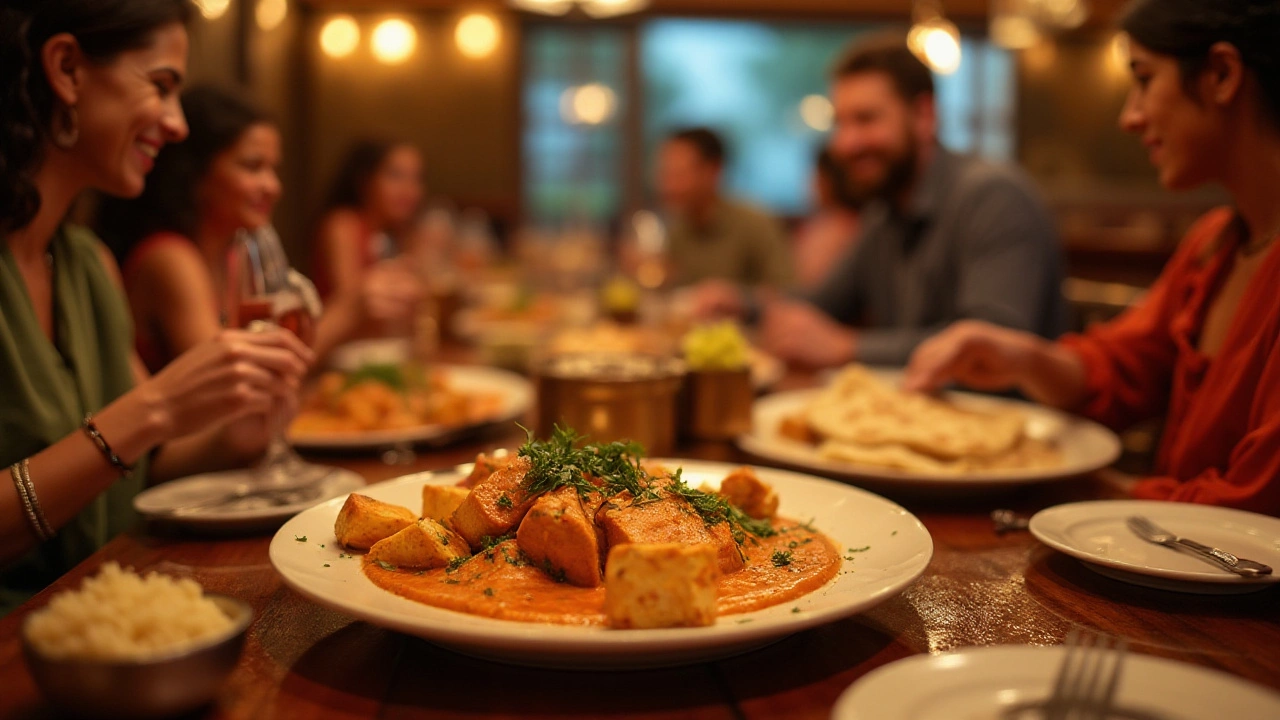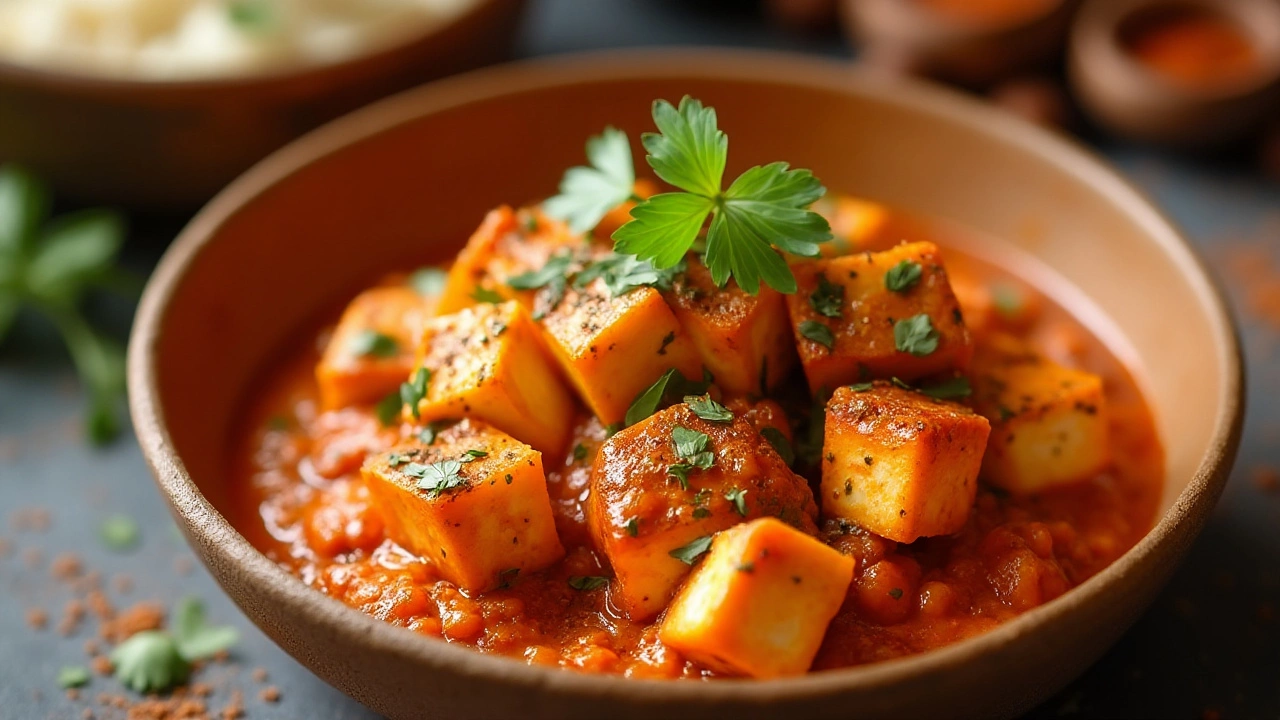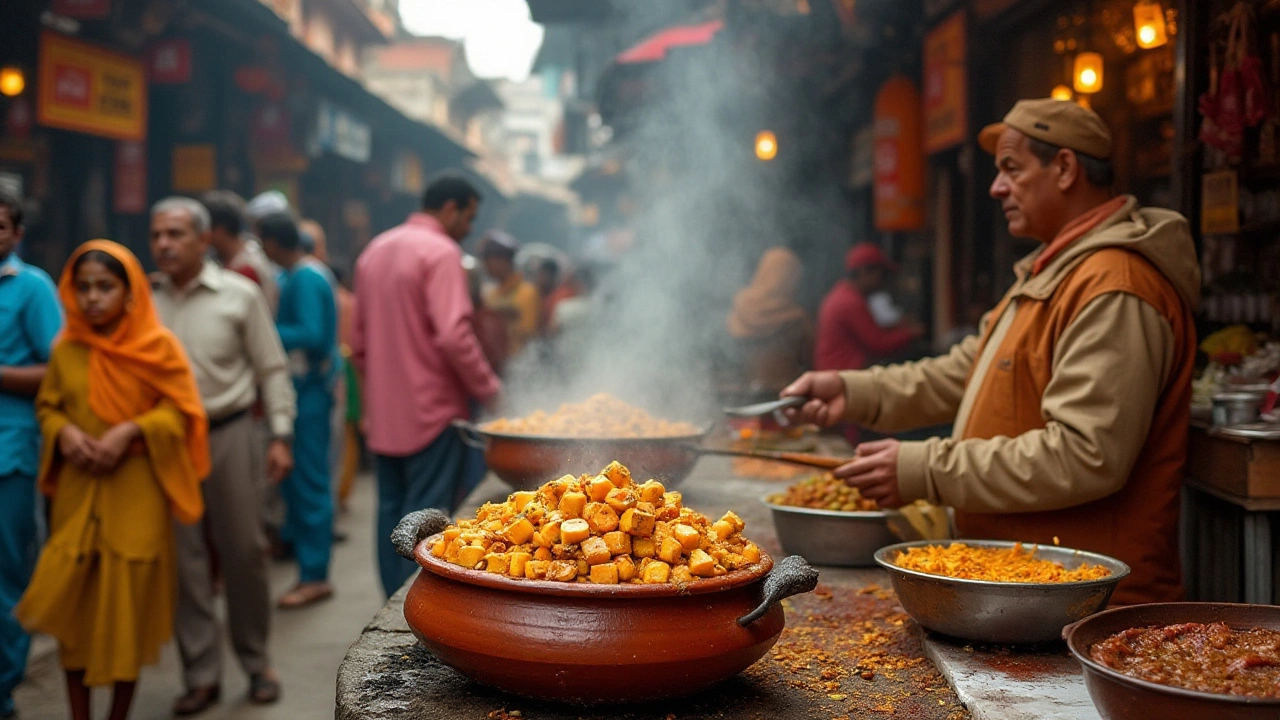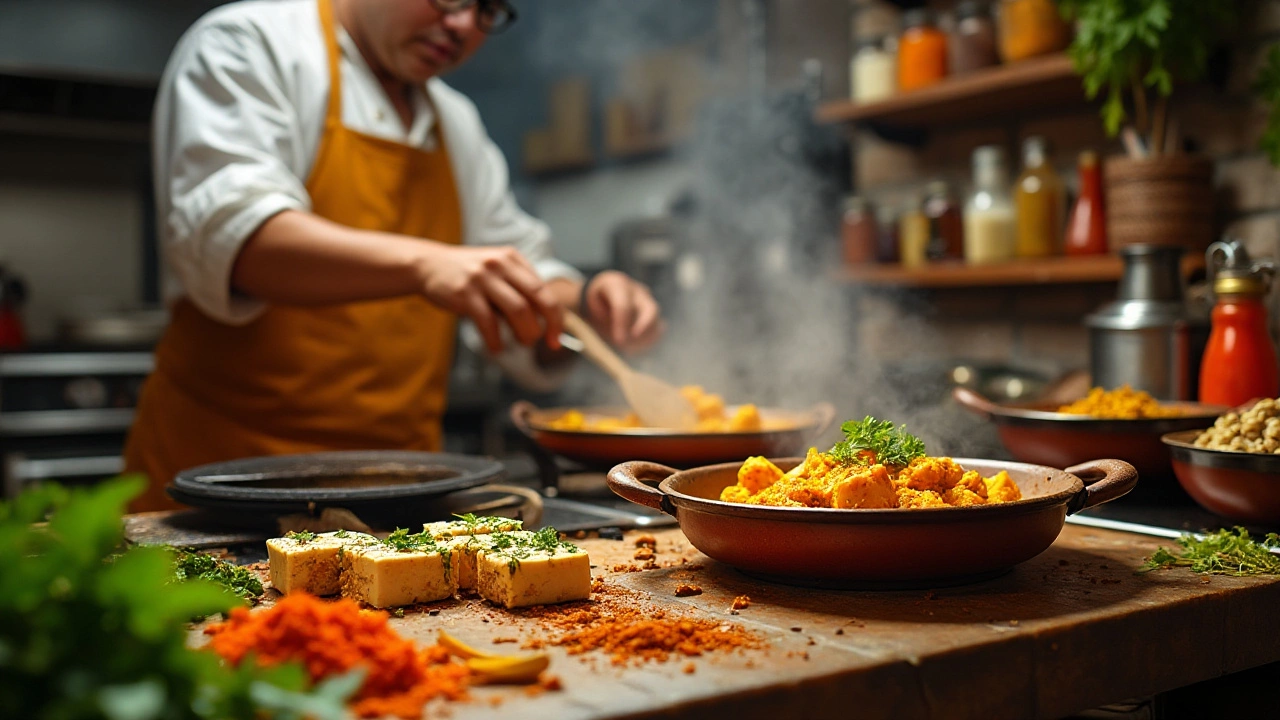When it comes to Indian cuisine, few vegetarian dishes can claim the degree of popularity and widespread admiration that Paneer Tikka Masala enjoys. Often praised for its creamy texture and aromatic spices, this dish encapsulates a perfect balance of heat and richness that tantalizes taste buds.
Originating from the subcontinent's traditional kitchens, Paneer Tikka Masala has made a global journey, finding a place in the menus of Indian eateries worldwide. Its vibrant orange hue, coupled with the succulent cubes of paneer, creates not just a visual delight but also an unmatched culinary experience.
But what makes this dish so adored? Its simplicity lies in the combination of fresh paneer, a medley of spices, and a well-prepared masala sauce. Each bite unfolds layers of complex flavors, a testament to the sophisticated yet accessible nature of Indian vegetarian fare. Stick around to delve deeper into this classic dish, revealing secrets for creating the perfect Paneer Tikka Masala at home.
- The Origin of Paneer Tikka Masala
- Key Ingredients and Cooking Technique
- Cultural Significance and Global Reach
- Tips to Make Perfect Paneer Tikka Masala at Home
The Origin of Paneer Tikka Masala
Paneer Tikka Masala, a dish synonymous with Indian cuisine, traces its roots back to the rich tapestry of India's cultural and culinary history. Its story is entwined with the introduction of dairy farming in India, which dates back thousands of years. Paneer, a fresh cheese, is believed to have been brought by Persian and Afghan rulers, although some contend it was present even earlier. The art of crafting paneer was embraced by Indian households, leading to its widespread use in various dishes.
The evolution of Paneer Tikka Masala specifically is less clear, although it likely draws inspiration from Tandoori traditions – a cooking method prevalent in North India. Tandoors, clay ovens used to grill meats, flourished in the region, primarily due to the Mughal influence. A defining moment for this vegetarian Indian dish might have been the adaptation of the classic Chicken Tikka Masala. Chefs, seeking to accommodate dietary restrictions or preferences, innovated by substituting meat with paneer. The result was a vegetarian delight retaining the rich marinade and smoky flavors of its predecessor.
Over time, Paneer Tikka Masala gained prominence not only within India's borders but among the Indian diaspora. It eventually became a fixture in Indian restaurants worldwide. This acceptance has won it accolades as a universal favorite in vegetarian Indian cuisine. An interesting anecdote is shared by renowned chef Sanjeev Kapoor, who once remarked, "The magic of paneer tikka masala lies in its ability to marry the humility of ingredients with the grandeur of flavors."
In identifying the precise origins of Paneer Tikka Masala, we delve not just into history, but also regional culinary traditions. Distinct variations might point toward the culinary hubs of Punjab and Delhi, renowned for their indulgent gravies and grilled delights. These regions are known to balance the use of spices and dairy, creating delectable dishes that have stood the test of time. Such legacy hints at a communal approach to cooking, which thrives even today where recipes are shared through generations, reflecting familial nuances in flavor and preparation.
The journey of this dish from a local favorite to an international icon also speaks volumes about the adaptability of Indian cooking. Dishes like Paneer Tikka Masala have become cultural ambassadors, serving as an introduction to a diverse cuisine for many. Its unique appeal lies in its ability to maintain authenticity while inviting interpretations, evidenced by varied recipes across different geographies. Ultimately, it is a testament to how food can transcend borders, with something as simplistic as paneer capturing the hearts and plates of millions around the world.

Key Ingredients and Cooking Technique
To appreciate the marvel that is paneer tikka masala, one must first understand its fundamental ingredients and preparation methods. At the heart of this beloved dish is paneer, a cheese native to India, skillfully made by curdling hot milk with a food acid like lemon juice. The texture of paneer is unique—firm yet soft, holding up well in cooking, thus making it a star in vegetarian Indian dishes. The next vital ingredient is the masala, a spice blend that brings life to the curry with its dynamic layers of flavors. This masala usually consists of a mixture including, but not limited to, coriander, turmeric, garam masala, and cumin. Each spice contributes its own distinct essence, elevating the dish with aromatic complexity.
Preparation of paneer tikka masala follows a dual-step process: grilling and stewing. The paneer is first marinated in a mix of yogurt and spices, allowing the flavors to infuse comprehensively. It's then grilled or baked until it attains a subtly smoky flavor, an essential characteristic imparted traditionally by a tandoor. Meanwhile, the masala sauce is prepared by sautéing onions, tomatoes, garlic, and ginger, with an addition of spices to deepen the taste. The artistic balance between marinating and the slow cooking of the masala is what creates the perfect harmony of flavors. Add cream to this mixture, and you’re left with a luxurious sauce enveloping the grilled paneer. This technique is not just about following steps; it's more an art form of pairing the right textures and timing. As the late Madhur Jaffrey, renowned culinary expert, once said,
"Indian cooking is part and parcel of rhythmic traditions."
For those interested in concocting this dish at home, having a few tips in your arsenal can be immensely helpful. First, ensure the freshness of the paneer, as its quality directly affects the dish's flavor. Freshly ground spices elevate the taste profiles, so whenever possible, freshly grind them. Another essential factor to note is patience during the preparation. Sauté the ingredients slowly, allowing each component to shine through and meld together. Garnish with fresh cilantro, which not only adds a burst of color but complements the spices. These intricacies make paneer tikka masala a true labor of love, and the effort is invariably rewarding when you take the time to execute it properly. Serve this dish with naan or basmati rice, and watch as it becomes a highlight on the dinner table.

Cultural Significance and Global Reach
Paneer Tikka Masala has emerged not just as a culinary masterpiece but as a cultural symbol of India’s rich vegetarian tradition. The dish reflects the ingenious use of spices and culinary techniques that have been passed down through generations, embodying the spirit of Indian hospitality. As a popular vegetarian Indian dish, it holds a special place both in the history and the modern dining scene of the country. The popularity of paneer, a fresh cheese made from curdled milk, dates back centuries and has always been a central element in Indian diets, celebrated in various forms. The method of marinating and grilling paneer originates from the Mughal era, adding layers to its cultural significance.
The global journey of Paneer Tikka Masala began in the latter half of the 20th century, coinciding with the migration of the Indian diaspora. Indian restaurants began to sprout in cities around the globe, and the dish rapidly gained a following due to its flavorsome appeal and vegetarian nature. Its creamy sauce and smoky, grilled paneer pieces presented a fresh alternative to non-vegetarian tikka variants, allowing people from diverse backgrounds to enjoy a piece of Indian culture. Indian cuisine, with its diverse range of flavors, was appealing to the Western palate which was increasingly seeking out new culinary experiences. As a result, Paneer Tikka Masala became a star in the Indian menu offerings abroad, often cited as the 'go-to' vegetarian option in many Indian eateries.
Paneer Tikka Masala's Appeal on the International Stage
Cross-cultural acceptance of this vegetarian Indian dish has been phenomenal. It resonates with those who appreciate hearty substances in their meals without compromising on flavors. In places like the UK, where chicken tikka masala is heralded as a national dish, its vegetarian counterpart, Paneer Tikka Masala, sees extensive popularity, affirming its strong foothold and the evolving preferences towards plant-based diets worldwide. In fact, the dish's ability to cater to diverse dietary preferences - be it vegetarians, flexitarians, or even those simply curious about trying new cuisines - contributes to its continued popularity.
The global reach of Paneer Tikka Masala has subsequently influenced food trends, encouraging innovations within the culinary community. Chefs around the world have put their unique spin on the dish, incorporating local ingredients and creative presentations to appeal to their respective audiences, yet retaining the core components that make the dish authentically Indian. Its versatile nature allows for pairings with a variety of side dishes – from naan and rice to modern accompaniments like quinoa or cauliflower rice. The aroma of Indian spices, exemplified in dishes like Paneer Tikka Masala, serves as an ambassadorial delight attracting those eager to immerse themselves in vibrant culinary adventures.
"Paneer Tikka Masala is a testament to culinary diplomacy at its finest. Its vast global appeal reflects a harmonious blend of taste, tradition, and timely innovation,” commented culinary expert Madhur Jaffrey in an interview about the influence of Indian cuisine worldwide.
The future of Paneer Tikka Masala appears brighter than ever as its demand continues to scale new heights, embraced by vegans and vegetarians and appreciated by omnivores alike. Its ability to adapt while still remaining authentically rooted in its Indian origins is a reason for its remarkable endurance. It isn’t merely a dish; it’s a celebration of Indian gastronomy open to exploration by food lovers everywhere.

Tips to Make Perfect Paneer Tikka Masala at Home
Creating a delightful Paneer Tikka Masala at home involves a journey through flavors and techniques. A dish known for its creamy gravy and savory marinated paneer, it requires attention to detail and a touch of patience. First, focus on marinating the paneer. Allowing the paneer cubes to soak in a yogurt and spice mixture is key to infusing them with flavor. This marinade typically includes ginger-garlic paste, red chili powder, turmeric, garam masala, and a tangy hint of lemon juice. Let the paneer marinate for at least an hour, but longer is better, letting the flavors deepen.
Neeta Mehta, a renowned Indian chef, once said, "The secret to any great dish lies in giving it time to breathe and let the spices work their magic."
For the sauce, ensure the tomatoes are ripe to deliver the authentic sweetness and balance the spices used. Fresh ingredients are vital, with garlic and ginger forming the foundation. Finely chop onions and sauté them until golden brown. Add a blend of spices—coriander powder, cumin, and more garam masala—to create the flavorful base. Allow these spices to release their aroma before adding the pureed tomatoes. As the sauce thickens, a splash of cream or cashew paste lends it the desired richness, transforming the dish into the beloved Indian cuisine classic.
Cooking the marinated paneer requires a hot grill or an oven to ensure a slight char. If you lack either, a pan on high heat can achieve similar results, just ensure the paneer becomes slightly crisp on the outside while maintaining its softness inside. This contrast in textures elevates the dish's enjoyment. Once prepared, these paneer pieces are added to the prepared sauce, allowing them to absorb the flavors. Stir gently and let the dish simmer to combine the harmonies, but not too long—maintaining the paneer’s delicate texture should always be a priority.
Pro Tips for an Extra Delicious Paneer Tikka Masala
To add depth, consider incorporating some smoked paprika to mimic the smoky tandoori style without needing a clay oven. Additionally, controlling the spice level is crucial; remember, a little spice goes a long way due to the cream. Don’t hesitate to garnish with fresh cilantro for a burst of color and freshness on serving. Some cooks add sugar to their sauce to balance acidity, a small suggestion that might just hit the perfect note. And last but not least, enjoy this meal with traditional naan or aromatic basmati rice, ensuring the complete experience of this favorite vegetarian Indian dish.
| Ingredient | Quantity |
|---|---|
| Paneer cubes | 250g |
| Plain yogurt | 100g |
| Red chili powder | 1 tsp |
| Garam masala | 1 tsp |
| Cream | 100ml |
| Tomatoes, pureed | 5 medium |
Equipped with these tips and a little practice, your efforts will result in a Paneer Tikka Masala that rivals that of any renowned Indian restaurant. Perseverance and attention to authenticity will unlock the genuine spirit of this dish, making it a staple in your home kitchen much like in countless homes and heart across India.
